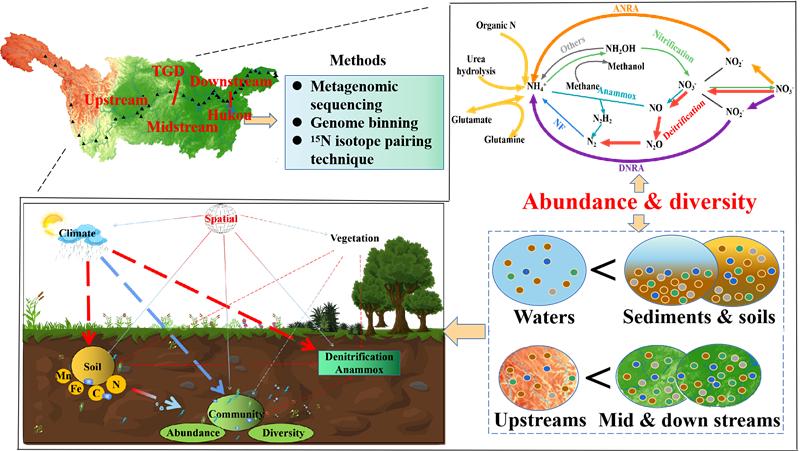Study Reveals the Relationship Between Nitrogen-cycling Microbial Communities and Nitrogen Removal
2024-09-30
Excess Nitrogen (N) input to the inland water bodies and marine ecosystem has contributed to a cascade of environmental issues, thus the N removal pathways are critical in aquatic and terrestrial ecosystems for maintaining homeostasis, and the associated functional microbes are of great importance for developing N management to protect the downstream water bodies.
Researchers from Wuhan Botanical Garden conducted metagenomic sequencing and genome binning to examine the abundance and diversity of N-cycling genes in surface water, channel sediments, and riparian soils along the Yangtze River suffered from severe N pollution.
The research obtained 121 metagenome-assembled genomes (MAGs) involved in N-cycling pathways, and the key MAGs belonged to the the Proteobacteria, and Alphaproteobacteria and Gammaproteobacteria were the main contributors for N-cycling genes at the class level, suggesting that those taxonomic groups may be the most dominant pollution in Yangtze River.
Significant difference of the abundance and diversity of most N-cycling genes were observed between soil/sediment and water, as well as between upstream and mid-downstream sites, implying that geographical factors or dispersal limitations play an essential role in shaping the biogeographic patterns of N-cycling genes.
The rates of N removal process significantly correlated with the abundance or diversity of several genes involved in N-cycling processes, and climate variables and soil physicochemical properties regulated denitrification and anammox rates both directly and indirectly through their effects on microbial genes.
The results fill a critical knowledge gap regarding the biogeographic patterns and environmental drivers of N-cycling microorganisms in river ecosystems from the metagenomic perspective.
This study was published in Water Research, titled "Metagenomic insights into nitrogen-cycling microbial communities and their relationships with nitrogen removal potential in the Yangtze River". DENG Danli is the first author and Prof. LIU Wenzhi, and XIONG Xiang are the corresponding author. This study was supported by the National Natural Science Foundation of China and China Postdoctoral Science Foundation.

Metagenomic insights into nitrogen-cycling microbial communities and their relationships with nitrogen removal potential in the Yangtze River (Image by DENG Danli)